UAB-VU BIOMIC Preparation of Left Fresh Frozen Eye
Jamie Allen, Jeff Spraggins, Angela R.S. Kruse, Jeffrey D. Messinger, David Anderson, Christine A. Curcio, Melissa Farrow, Kevin Schey
Abstract
Scope:
This protocol describes the process of procuring donor eyes from Advancing Sight Network, the processing and freezing of the left eye, and the sectioning of tissue for the HuBMAP Eye project.
Glossary of Terms (Figure 1):
- Anterior - Refers to the front part of the eye – right side of Figure 1 – the light shines in from this aspect
- Anterior segment - includes iris, cornea, pupil aqueous humor, and the conjunctiva (not shown).
- Cornea - Clear, and continuous with sclera; allows light to enter into the eye to the retina, at the back of the fundus.
- Choroid - Vascular bed of blood vessels to nourish the posterior half of the retina.
- Fovea -Small depression in the retina, in the back of the eye, specialized for detailed and color vision.
- Fundus - A term used for the lining of any organ. The ocular fundus consists of the neurosensory retina, RPE (retinal pigmented epithelium) and the choroid.
- Iris - Controls the amount of light entering the eye.
- Lens - Changes shape to allow viewing of close or distant objects.
- Macula lutea – yellow spot due to xanthophyll pigments, containing the fovea
- Optic nerve - Transfers visual information from the retina to the brain.
- Posterior - refers to the back part of the eye – left side of Figure 1.
- Posterior segment - All parts of the eye that are located behind the lens. Usually referring to the retina between the optic disc and the macula.
- Pupil - Opening formed by the iris, varies in size with ambient light.
- Retina - lining the fundus in the back of the eye; receives light signals and convert them into neural signals and send those signals through the optic nerve back to the brain.
- Sclera - White part of the eye that maintains its shape, for optical alignment and muscle attachment.
Steps
Positioning and Marking Globe
Whole donor globes on wet ice are received within less than 6 hours’ time of death (TOD) from the Advancing Sight Network (500 Robert Jemison Rd Birmingham, AL 35209).
Tissue orientation is preserved using tissue marking dyes in black, red and yellow (identifying the superior rectus muscle, approximate location of fovea, and optic nerve head respectively)
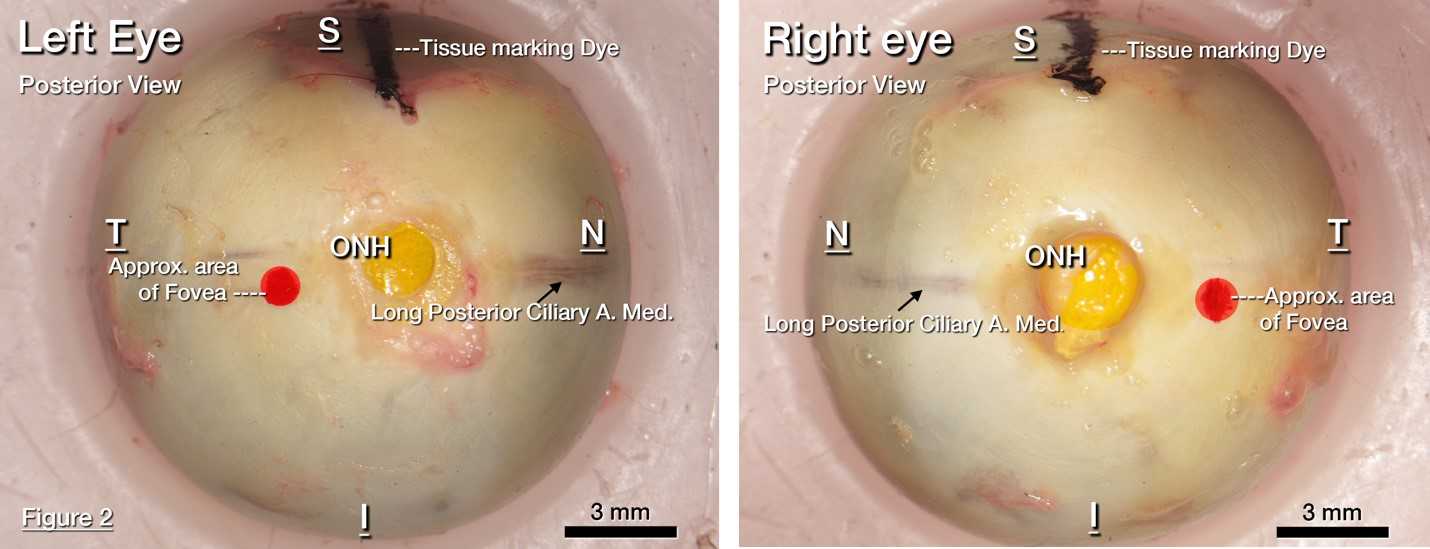
Freezing of Globe
Breach the vitreous cavity to create a pressure release upon quick freezing as follows:
Insert an 18 gauge needle 5 mm slightly tangential to the sclera. The puncture should be made into the black tissue mark in the posterior to anterior direction.
Insert just to the point where the tip of the needle penetrates the sclera and breaks into the vitreous humor.
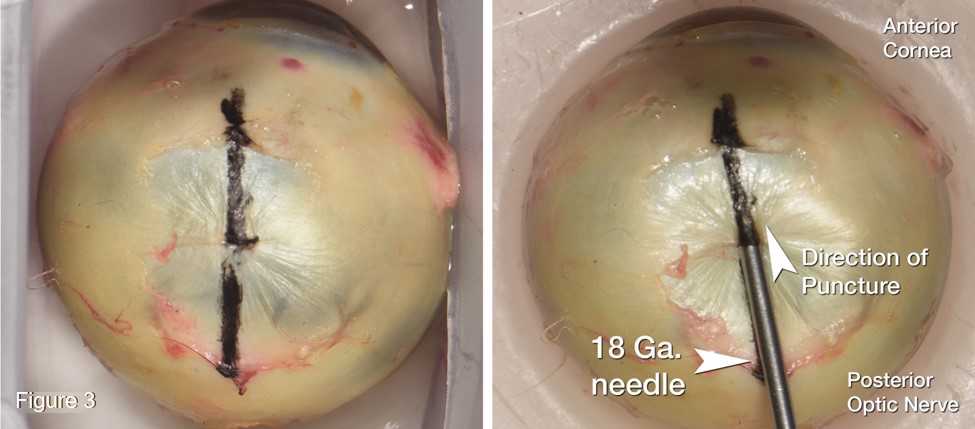
A slight leakage of the vitreous fluid will occur when the needle is retracted.
Create a double-stacked cryomold by carefully removing the bottom of a Peel-A-Way embedding mold using a razor blade or similar. It will stack neatly on top of a second cryomold. This allows for sufficient height within the molds to fully embed the tissue.
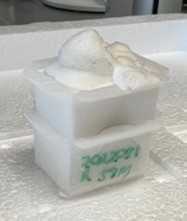
The molds are filled with 5 mL of cold 15% fish gelatin. Liquid nitrogen is used to semi-freeze the fish gelatin until semi-solid and tacky for sample adherence to the cryomold. Use forceps to suspend the mold within the liquid nitrogen, ensuring that it does not flow over top of mold.
Using a stereo microscope, place the whole globe into the anatomically labeled double-stacked cryomold matching the tissue dye orientation. The globe is oriented so that the superior edge (black tissue mark) faces upwards within the cryomold and the cornea faces the shorter, 25-mm, end of the rectangular mold.
Fill the mold with 15% fish gelatin.
Quickly freeze embedded globe with liquid nitrogen. Use forceps to suspend the mold within the liquid nitrogen, ensuring that it does not flow over top of mold.
Place in Britran Freezer bag and store in -80°C freezer to await shipment.
Globe Dissection
In order to obtain reproducible sections with minimal warping, the embedded globe is dissected into two halves: the anterior segment and the optic nerve/macula regions. All cutting must be performed in an enclosed container within a HEPA-equipped fume hood to prevent contact with donor tissue. Proper personal protective equipment including face shield, gloves, Tyvek IsoClean Sleeves, and lab coat must be worn at all times in accordance with BSL2 certification.
First, the anterior segment (containing cornea, iris, lens, ciliary body, limbus) is removed with a Dremel rotary cutting tool.
The Dremel 545 Diamond Wheel and rotary shield are attached to the cutting tool
The tool is placed in a fixed position using a Dremel Multi Vise that is modified to have a weighted stand as shown in Figure 5:
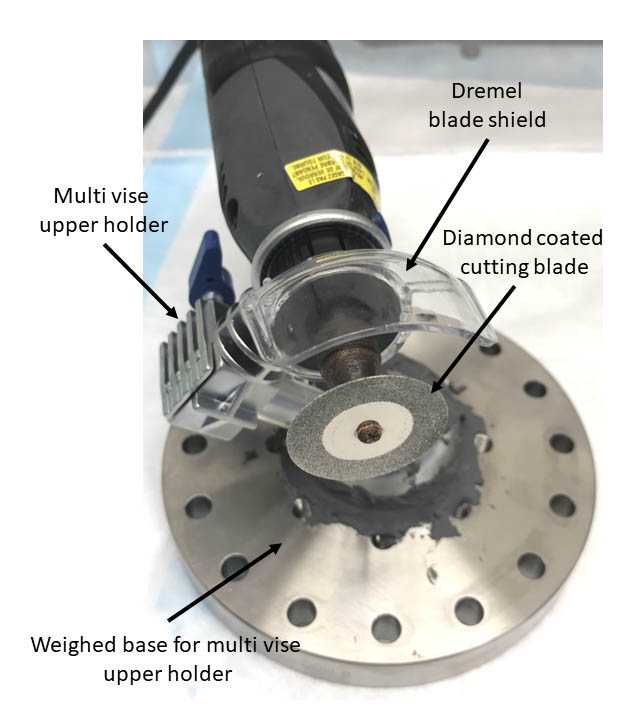
The stationary Dremel cutting tool apparatus is placed below a rectangular acrylic shield and wrapped in an absorbent disposable bench under-pad. This protects the tool from contamination with tissue.
Dry ice is placed below to aid in keeping the sample frozen while cutting as shown in Figure 6: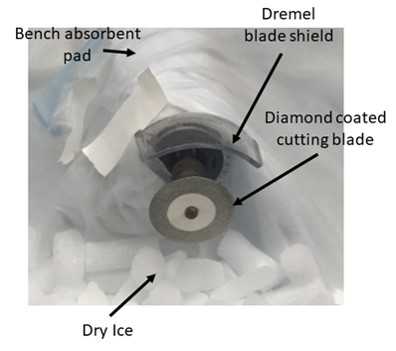
The embedded globe is cut by carefully rotating the block on the cutting wheel along the indicated black line (Figure 7) to separate the anterior and posterior segments of the globe as shown in Figure 8:


Place both halves back into cryomold. Making sure to preserve the orientation by placing them back in the original position in which the whole globe was removed. Wrap in foil and store in the -80°C.
Sectioning the Globe Blocks
Before sectioning, the globe halves are removed from the -80°C freezer and left in the cryostat chamber for 30 minutes to equilibrate to -20°C.
Mount the posterior globe block onto a cryostat chuck using polyethylene glycol (Optimal Cutting Temperature Polymer) ensuring good attachment.
Note the orientation (nasal-to-temporal cross-sectional cut) markings on the mold that match the optic nerve head and fovea. Use these and the inked landmarks to mount the block half with the nasal side towards the cutting face (Figure 9).
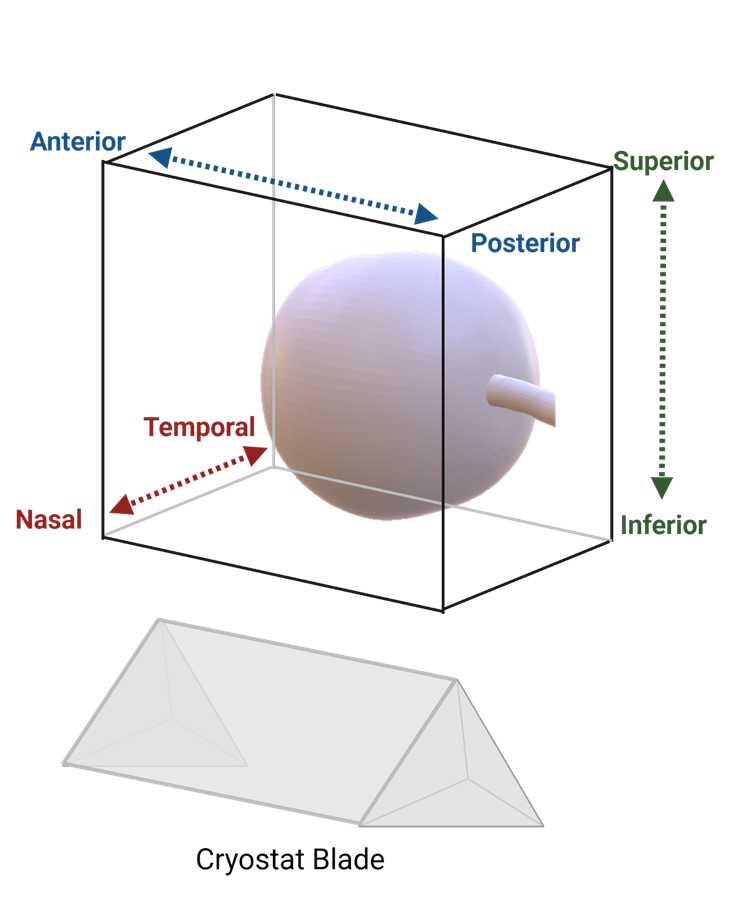
The tissue is trimmed by sectioning relatively thickly (up to 20 µm) until the yellow dye is seen (and extension of dura mater along the length of the nerve).
Locate the optic nerve head by noting how the optic nerve protrudes and invaginates through the RPE layer. The optic nerve vein and artery should be located approximately 800µm from the beginning of the optic nerve head.
Sections through the optic nerve were then collected for all analysis modalities: Imaging Mass Spectrometry, CODEX, lipidomics and proteomics. Sections for other modalities may be collected as needed.
*Note: sections placed on slides must be thaw mounted onto slides until dry. Sections for IMS are vacuum desiccated for a minimum of 30 minutes. Proceed directly to step 15.
Continue sectioning an additional ~1.5 mm to reach edge of the macula. Confirm the macular location using a light microscope to look for the Henle fiber layer (a layer of neuronal and glial processes).
Collect sections for the same modalities as in step 13.2. When finished sectioning, remove block from chuck and place what is left back into the mold.
*Note: sections placed on slides must be thaw mounted onto slides until dry. Sections for IMS are vacuum desiccated for a minimum of 30 minutes. Proceed directly to step 15.
Mount the anterior segment block onto a cryostat chuck with the temporal side facing the observer and the nasal side on the mounting surface (Figure 10).

Trim the block until the ocular lens is visible as this indicates the central region of the anterior segment. Use the appearance of the iris and the pupil (gap in the iris) to help aid in the start of section collection. Collect suitable sections of the entire anterior segment with minimal wrinkling or warping.
*Note: sections placed on slides must be thaw mounted onto slides as flat as possible until dry. Sections for IMS are vacuum desiccated for a minimum of 30 minutes. Proceed directly to step 15.
When all sections are collected, place the block in the cryomold with the remaining posterior block.
Autofluorescence and Storage
Autofluorescence microscopy images are collected on all sections before analysis. If slides are frozen, place them in a vacuum desiccator for 20 minutes to come to room temperature and completely dry.
Autofluorescence Microscopy Data Acquisition
When finished, slides placed in slide mailers and sealed in food-grade vacuum freezer bag using a food-grade vacuum sealer. Slides are then stored at -80°C to await analysis.
Sections for IMS analysis are now ready for matrix application (via Sublimation) or other omics processing.
Matrix Sublimation via In-House Developed Sublimation Apparatus


